Revue en profondeur de l'athlète Garmin MARQ
Cela fait presque cinq mois que Garmin a annoncé pour la première fois ses montres haut de gamme de la série MARQ, qui s’élèvent à 2 500 dollars US pour l’édition Driver. Bien que la variante de l’athlète sur laquelle cette critique est axée, vous ne vous remettiez «que» 1 500 $. En tout, cinq unités MARQ différentes, représentant chacun des principaux secteurs d’activité de Garmin (aviation, plein air, fitness, marine et automobile).
Pendant la majorité de ces cinq mois, le MARQ a été à mon poignet gauche. J'ai plus de données MARQ que je ne sais quoi faire. Mais plus important encore, il faut plus de temps que la plupart des critiques pour se plonger dans les bons… et ensuite, les moins impressionnants, de l'utilisation de l'unité.
Maintenant, avant que nous allions trop loin dans les choses, il faut réaliser que lorsque vous parlez de montres en milliers de dollars – ce n’est plus à propos des fonctionnalités. Après tout, le nouveau Garmin FR945 à 599 $ contient toutes les fonctionnalités logicielles du MARQ Athlete. Sérieusement, tout cela (et a une meilleure durée de vie de la batterie). Au lieu de cela, acheter quelque chose comme la série MARQ est parce que vous voulez son apparence. Que l'on se sente ou non dit que le look vaut ce prix-là est une question différente, la réalité est que les gens achètent ces montres comme j'achète du matériel photographique coûteux. Et tout comme cet appareil photo, ces montres seront pour la plupart obsolètes d’ici 3 à 5 ans. Mais nous y reviendrons un peu plus tard.
Voyons d’abord un aperçu de toute la série. Si vous avez déjà vu ma publication pratique il y a quelques mois, vous pouvez ignorer cette section suivante. Oh, et enfin, j’utilise un prêt média de Garmin (deux unités en fait). Une fois que je termine cet examen, je vais (extra) emballer soigneusement ces sauvegardes et les renvoyer avec toutes les cases d’assurance supplémentaires cochées. Si vous avez trouvé cet avis utile, vous pouvez devenir un supporter / membre de la DCR et aider à soutenir le site. Je vous en suis reconnaissant!
Contenus
La série MARQ:
Avant d’entrer dans toutes les nuances de l’athlète MARQ, nous allons revenir en arrière et discuter de la plus grande série MARQ. Si vous avez déjà vu mon premier message pratique sur MARQ, franchement, vous pouvez ignorer cette section – elle est presque identique.
La série MARQ comprend cinq versions, chacune visant un marché différent. Garmin a effectivement pris les variantes d'extrémité inférieure de chacune de ces montres et les a élevées du point de vue des matériaux et de l'interface utilisateur. Par exemple, la montre Aviator est basée sur le D2, les montres Expedition et Athlete sont basées sur le Fenix 5 Plus (avec des éléments du FR945) et le capitaine sur le Quatix. Les fonctionnalités logicielles sont donc toutes conservées, avec toutefois de nouveaux ajustements matériels, tels qu'un jeu de puces GPS différent et un capteur de fréquence cardiaque optique différent, ainsi que plus du double de l'espace de stockage de la série Fenix 5 Plus.
Je vais passer brièvement en revue chacune des versions ci-dessous en termes de caractéristiques principales, ainsi qu’une petite galerie de photos pour siroter votre café.
Caractéristiques communes:
Toutes les montres ont la même ligne de base, ce qui est essentiellement les caractéristiques des montres de la série Fenix 5 Plus, avec quelques rebondissements. Cela comprend donc:
– Cartes détaillées de la région où vous l'avez acheté (par exemple, l'Amérique du Nord)
– Lecture / stockage de musique hors ligne, incluant le support Spotify
– Assistance au paiement sans contact Garmin Pay (chargement de cartes de crédit, etc.)
– Mesure PulseOx SpO2
– Nouvelles fonctionnalités physio autour de la charge d'entraînement, de la récupération et de l'acclimatation
– Natation / Vélo / Course / Golf / Ski, et de nombreux autres sports tout compris
– Base de données mondiale complète des pistes de ski / cartes incluses
– Base de données mondiale complète des terrains de golf incluse
– Interface utilisateur revampée pour la gamme MARQ
– Capteur HR optique optique Garmin ELEVATE revampé (officiellement appelé «Gen3»)
– Toutes les montres disposent de fonctions de détection d'incident et d'alerte de sécurité (similaires à Vivoactive 3 Music LTE, sauf sans LTE)
Maintenant, il y a quelques rebondissements intéressants ici. Par exemple, ci-dessus, vous voyez la base de données des stations de ski, qui est nouvelle pour Garmin et qui commence par MARQ. Ils ont eu un mode de ski, mais pas une carte de ski alignée à cela pendant le ski. Donc c’est cool. Cependant, Garmin Connect Mobile (sur votre téléphone) ne dispose pas de la superposition de cartes: les choses se détériorent un peu une fois que vous téléchargez votre journée de ski. Pourtant, c’est un progrès.
En passant légèrement, il y a quelques notables spécifiques au matériel qui sont communs à toutes les variantes:
– Taille plus petite de 46 mm (donc identique au Fenix 5 / Plus, pas aux modèles S ou X)
– Durée de vie de la batterie: 12 jours en mode veille, 28 heures sur GPS, 48 heures sur UltraTrac GPS
– Lunette en céramique: pour les éditions Aviator, Captain et Driver
– Nouveau câble de charge: comme un mélange entre les câbles Fenix 5 et les câbles Forerunner 645
Sur la lunette en céramique, Garmin m'a fait remarquer à maintes reprises, à plusieurs reprises et sur plusieurs continents, qu'ils avaient pris des mesures extrêmes pour essayer de trouver un matériau ultra-résistant aux rayures par rapport à toute autre montre jamais fabriquée. Plusieurs mois plus tard, je n’ai pas encore réussi à gratter le mien, mais je ne l’ai pas traîné non plus le long des murs en béton. Je suis maladroit, donc au moins jusqu’ici, tout va bien.
Du point de vue du service, toutes les montres partagent le même niveau, peu importe où elles ont été achetées:
– 2 ans de garantie complète
– 5 ans d’entretien des pièces à compter de la date d’achat (c’est-à-dire que si acheté en juin 2021, il irait jusqu’en juin 2026)
– Programme de remplacement de la batterie chez Garmin et chez le concessionnaire
La glissière pour permettre le remplacement de la batterie par le concessionnaire est un tournant intéressant. Les clients précédemment requis de Garmin les contactent directement via leurs canaux d'assistance. Ce remplacement de la batterie s’aligne donc plus étroitement avec les magasins de montres haut de gamme.
Les deux choix matériels fondamentaux que Garmin a faits sont encore plus intéressants:
1) Ils sont passés aux jeux de puces GPS Sony (un choix qui a été répété pour toutes les montres / ordinateurs de vélo lancés en avril / mai)
2) La capacité de stockage a été augmentée jusqu’à 32 Go – une énorme mise à niveau par rapport à la solution standard de 8 à 16 Go utilisée par Garmin dans d’autres unités.
Le premier changement a été le plus grand changement de cap que nous ayons vu depuis des années. Jusqu'à MARQ, toutes les montres les plus récentes utilisaient des chipsets GPS MediaTek. En fait, Sony est un acteur relativement nouveau dans cet espace. Mais ils ont attiré beaucoup d’attention en raison de leur profil de puissance extrêmement faible. Suunto et Polar se sont tous deux tournés vers les chipsets GPS Sony cette année pour leurs montres haut de gamme, mais cela ne s’est pas très bien passé. COROS a également introduit une montre avec elle aussi – et encore une fois, la précision du GPS n’était guère brillante. C’est un pari dangereux pour Garmin. Ils confient effectivement leur capacité à «résoudre» les problèmes liés au GPS de Sony, afin de réduire la durée de vie de la batterie. Est-ce que ça marche? J'ai eu plus de réflexions plus tard dans la publication après avoir fait quelques tests.
Le deuxième changement lié à l'espace de stockage est également intéressant mais déroutant. En adoptant un espace gigantesque de 32 Go, Garmin ouvrirait la voie à bien plus de cartes disponibles sur le périphérique. Malgré cela, Garmin ne charge que les cartes de la région locale, et non l'ensemble complet de cartes détaillées internationales. Vous devez donc toujours payer les cartes lorsque vous voyagez ou les télécharger en procédant par étapes maladroites auprès de tiers. Je ne vois pas comment les gens qui dépensent 2 500 dollars en montres veulent prendre ces mesures. Cela semble dérisoire de Garmin.
Différences entre l'édition d'athlète:
Cette variante est aussi proche d'un Fenix 5 Plus que vous pouvez obtenir d'un point de vue fonctionnalité. Mais il propose également toute une série de nouvelles fonctionnalités axées sur la condition physique que Garmin a encore développées en mai avec la série Forerunner 45/245/945:
– Ils ont amélioré le prédicteur de course
– Ils ont ajouté une concentration sur la charge d'entraînement et des détails plus profonds sur l'effet d'entraînement
– Ils ont ajouté de l’acclimatation à la chaleur et à l’altitude, y compris une compensation VO2Max / Statut de formation pour la chaleur
– Ils ont ajouté le taux de respiration
– Ils ont ajouté la détection des incidents et la sécurité / assistance au suivi
– Ils ont ajouté PulseOx (pas sur toutes les unités Fenix 5 Plus précédemment, uniquement sur le 5X Plus.
La quasi-totalité des mesures annoncées ci-dessus sont gérées par FirstBeat. La plupart d’entre eux ne sont pas si différents qu’auparavant, mais ils se manifestent de manière plus nette. Je vais me plonger dans la section des athlètes ci-dessous. Notez que l'édition Athlete est uniquement fournie avec un bracelet en silicone, ce qui, honnêtement, me déçoit un peu. Après tout, il existe des variantes de Fenix 5 Plus pour environ 500 dollars de moins, qui incluent à la fois un bracelet en silicone et un bracelet en métal fantaisie – et le FR945 encore moins cher avec exactement les mêmes caractéristiques.
Différences avec l'édition d'expédition:
Cette variante équivaut à prendre un Fenix 5 Plus, mais en orientant ensuite la direction vers un suivi à plus longue portée et en s'éloignant des caractéristiques sport / fitness normales. Les deux bits uniques comparés à une unité de la série Fenix sont les suivants:
– Application d'expédition: vous permet de suivre 4 semaines consécutives de suivi GPS à intervalles de 1 heure
– Verrouillage de l'orientation: vous permet de verrouiller un en-tête depuis la vue cartographique en maintenant le bouton de démarrage enfoncé.
Et encore une fois, pour ces fonctionnalités, je vais les décrire en bas dans la section détaillée Athlete / Expedition. Le premier, qui concerne une piste GPS de quatre semaines, est fascinant. Pas seulement à cause du côté montre de la maison, mais aussi de Garmin qui travaille sur la plate-forme dorsale pour s’assurer qu’elle prend correctement en charge les fichiers téléchargés à partir de celle-ci. L’expédition comprend un bracelet en cuir italien Vacchetta. Sans aucun doute, c’est la plus jolie des toutes les éditions à mes yeux.
Différences édition aviateur:
Cette montre est basée sur l'unité Garmin D2 PX Delta (elle-même basée sur la série Fenix 5 Plus). Il se concentre sur le pilotage d’un avion, y compris l’intégration de certains systèmes de gestion de vol de Garmin via le flux de vol 510, et propose des cartes de l’aviation et des bases de données d’aéroports préchargées. [Updated] De plus, au-delà de toutes les fonctionnalités de la montre D2 PX Delta (sortie en juillet dernier), il ne semble pas y avoir de nouveauté. Les trois fonctionnalités ci-dessous, que Garmin a notées comme nouvelles, ont été ajoutées via une mise à jour de firmware au D2 PX en décembre.
Je suis un peu un geek de l’aviation. Un de ces jours, je terminerai ma licence de pilote. Mais en regardant ceci et le D2 PX, il y a tellement de choses sympas ici, en particulier autour du radar météo NEXRAD. Un de ces jours, je vais l’utiliser aux fins prévues. Le bracelet est en titane avec un «design d’aile en flèche multibras» (leur description, pas la mienne).
Différences entre Captain Edition:
Cette montre fait suite à la série Garmin Quatix et constitue une amélioration notable par rapport à la Quatix 5, puisque cette unité est basée sur la série Fenix 5 et non 5 Plus. Donc, cette variante gagne tous les morceaux de musique / paiement sans contact / mappes qui manquaient. L'objectif principal ici est de vous connecter aux unités marines de Garmin pour contrôler votre bateau depuis votre poignet. Par exemple, lorsque vous êtes connecté au GHC 20, vous pouvez contrôler le pilote automatique. Il prend également en charge les touches de raccourci pour des actions telles que le traçage d'homme à la mer et la navigation automatique vers celui-ci, ainsi que des fonctions telles que les alarmes d'ancrage et les modes d'assistance au point.
Avec l'édition Captain, ils ajoutent ce qui suit:
– Visage météorologique actuel, y compris au port d'attache
– Minuterie de régate avec GPS et marquage de la lunette dédié à l’aide de la touche de raccourci démarrage / arrêt
Et encore une fois, la grande mise à jour ici est également la cartographie par rapport à la précédente Quatix 5, qui ne contenait pas de cartographie. Le bracelet est Jacquard Weave et est vraiment magnifique dans la vie réelle. Si cela n’était pas si coûteux, je le prendrais certainement pour mon appareil Fenix 5 Plus.
Différences entre les éditions de pilotes:
Ok, "différences" est le mauvais mot ici. Parce que Garmin n'a jamais créé de montre dans cette catégorie auparavant. C'est donc une première pour Garmin. Il s’agit néanmoins de nouvelles fonctionnalités qui vont bien au-delà de ce que Garmin Fenix propose aujourd’hui. Elles sont toutes destinées à la conduite par rapport à la conduite sportive. Elles sont:
– Plus de 260 pistes de course pré-chargées (liste complète ici)
– App course
– Minuterie de piste
– Heure Delta Live
– Découpages automatiques en fonction de la position
– Score de répétabilité du temps par tour (LTR)
– Résumé de la dernière course
– Mur de puits virtuel
Malheureusement, je ne peux pas facilement tester cet élément en particulier, et comme il n’existe aucun contexte passé sur lequel baser des fonctionnalités, ma capacité à en discuter en profondeur est quelque peu mince. Malgré tout, je suis allé de l'avant et j'ai essayé de trouver ces fonctionnalités et ces applications sur la montre aussi bien que possible pour la galerie ci-dessous.
Ouf, tu as tout ça? Bien, c’est beaucoup de bonté visuelle pour vous! Pour vous rafraîchir la discussion, voici un graphique astucieux de Garmin qui indique le nombre de palourdes que vous allez devoir débourser pour chaque version:
Des semaines! Au moins ils sont jolis.
Il est intéressant de noter que vous ne les trouverez dans aucun des détaillants / magasins Garmin que vous connaissez aujourd’hui. Garmin ne vendra ces montres que dans des boutiques de montres haut de gamme (certaines d'entre elles vendaient auparavant la gamme Garmin CHRONOS, mais la plupart sont nouvelles pour Garmin). C’est un grand changement pour Garmin, qui n’offre pas les montres par l’intermédiaire de détaillants spécifiques à chaque groupe de produits. Selon Garmin, les clients qui recherchent cette gamme de montres s’attendent à ce que leurs clients s’adressent à des revendeurs qui vendent TAG, Breitling et d’autres – et ont donc probablement déjà un lien avec ce magasin de montres.
C’est peut-être vrai, mais c’est aussi discutable. En tant que coureur, je n’irais jamais dans un magasin de montres haut de gamme pour trouver une course… euh… une montre d’athlète. De même, si j’aimais les équipements marins de Garmin (où j’aurais probablement perdu plus de 10 000 dollars pour leurs systèmes), j’irais probablement chez mon revendeur. Pareil pour l'aviation, etc. Je ne suis pas vraiment sûr de trouver quelqu'un qui comprend parfaitement les nuances de toutes les fonctionnalités techniques d'une montre Garmin chez un revendeur de montres haut de gamme typique. Et compte tenu de la technicité de Garmin, cela semble discutable.
En fait, à compter d’aujourd’hui, si vous souhaitez en acheter un aux États-Unis, le mieux est de vous rendre chez Macy. Vous savez où vous achetez des chaussettes, des sous-vêtements et des mixeurs de stand Kitchen Aide en vente avec un coupon de 20% provenant de votre circulaire du dimanche. Toutefois, le coupon de sous-vêtements de ce week-end n’est pas valable sur la série MARQ. J'ai vérifié.
Notez que je ne prévois pas d’examiner les éditions Driver, Aviator, Captain ou Expedition. Principalement parce qu'il me manque actuellement une voiture de course, un avion, un bateau ou une montagne. Si quelqu'un souhaite me donner un de ces objets, je me ferai un plaisir de revoir lesdites montres.
Déballage:
Soyons honnêtes, l’extérieur initial de la boîte Garmin MARQ est horriblement décevant. C’est juste une boîte blanche vierge. Moins excitant que même la boîte blanche la plus discrète de stupéfiants illégaux.
Cependant, une fois que vous enlevez l’extérieur de vanille, vous vous retrouvez avec une boîte beaucoup plus intéressante… euh… un cas. Eh oui, c’est un vrai boîtier en métal. De taille approximative, ressemble à l'une de ces boîtes de tissu squarish.
Casser le couvercle sur cette affaire d'artillerie et vous trouverez une petite pile de paperasse, qui comprend une carte de garantie internationale. Une tentative d'être comme les sociétés de montres de fantaisie.
Je suis cependant curieux: si vous achetez chez Macy, obtenez-vous un «timbre» de Macy à cet endroit? Je veux dire, demander juste un ami.
Vous trouverez ci-dessous la montre qui vous regarde avec envie:
Retirez quelques jeux et voici ce que vous avez:
Il ya une carte dure qui réchauffe le cœur d’un côté et qui constitue le meilleur moment de motivation que le Kansas puisse rassembler, et l’autre côté explique la signification du bouton MARQ et de la vie de la lunette:
Ensuite, vous avez le câble de charge / synchronisation très serré. Aucun câble Garmin jamais produit n’a montré autant de personnalité de type A.
Celui-ci scintille même à la lumière, sachant qu’il est totalement unique dans la famille Garmin – compatible avec rien d’autre que la société ne fabrique.
Quant à la montre elle-même, en voici l’arrière. Ne craignez rien, nous en verrons beaucoup le visage d’ici la fin de cet examen:
Vous pouvez libérer les bandes en appuyant sur les petits boutons situés sous les bretelles les plus proches de la montre. Cela vous permet de dépenser 100 $ de plus pour des sangles supplémentaires. En-dessous, vous trouverez les coordonnées du siège de Garmin à Olathe, au Kansas. Je tiens également à vous informer que le produit est toujours fabriqué à Taiwan, comme tous les autres appareils Garmin Fitness / Outdoors.
Avec cela, vous êtes prêt à tout associer à votre téléphone via l'application pour smartphone Garmin Connect Mobile de Garmin.
Techniquement, vous n’êtes pas obligé de le faire, c’est ainsi que vous obtiendrez des informations telles que les notifications par smartphone, la configuration de services de diffusion en continu comme Spotify et la synchronisation automatique de vos séances d’entraînement sur des sites comme Strava. Parmi un million d'autres choses.
Notions de base au jour le jour:
Cette section présente essentiellement les bases de la montre et son fonctionnement avec Garmin Connect Mobile. Si vous avez déjà visité le bloc de montres Garmin plusieurs fois, honnêtement, rien de tout cela ne sera vraiment nouveau. Ce qui différera cependant, c’est l’interface utilisateur, qui est mise à jour sur la montre par rapport à une série de Fenix 5. Pas radicalement différent, mais néanmoins différent.
Toutefois, si vous êtes totalement nouveau dans le domaine des montres Garmin et si vous lisez ceci, considérez cette section comme un peu simple.
Le premier est le cadran de la montre. Chaque montre MARQ a un cadran unique pour cette édition. Comme presque toutes les montres Garmin, celles-ci sont personnalisables avec les cadrans de l'app store Connect IQ, mais également en modifiant pratiquement toutes les données que vous voyez sur celui-ci.
Toutes les montres ont la même disposition de boutons, et cela reflète la série Fenix. Les boutons haut / bas de gauche parcourent les widgets. Ceux-ci incluent la météo actuelle (widget récemment réaménagé), votre dernier entraînement, le statut de votre entraînement, son historique, sa musique, ses statistiques de santé et bien plus encore. Voici une petite galerie de ce à quoi il ressemble. Notez que la quasi-totalité de ces widgets ont eu une modification de l'interface utilisateur (interface utilisateur) par rapport à la série Fenix:
Le bouton du milieu sur le côté gauche permet d'accéder à la zone de contrôle des paramètres. C’est à la fois pour les sports / applications individuels, mais aussi pour les réglages de la montre. Cela aussi commence comme dans la série Fenix 5, mais modifie l’interface utilisateur plus bas dans le menu. Les options de configuration ici sont toutes les mêmes que je puisse dire, simplement réorganisées.
Ensuite, vous avez le bouton en haut à droite. Si vous appuyez dessus une fois, cela vous mènera à la sélection du mode sport. C’est également à cet endroit que vous choisirez de lancer les applications que vous avez téléchargées. Encore une fois, ceci est mis à jour. La vue de la terre derrière chaque sport / application est en constante évolution. Il s’agit d’une véritable animation sans fin dans la vie réelle qui ajoute une touche agréable aux choses.
En sélectionnant un sport ou une application, il s'éteint et commence à se connecter aux capteurs appropriés, ainsi qu'à acquérir le GPS. Donc, pour l'édition Athlete, cela signifie que vous devez vous connecter à des capteurs sportifs tels que des capteurs de vitesse / cadence / puissance (et bien plus encore). Pour l’édition Aviator, c’est aux systèmes de gestion de vol et à l’unité Marine, à la suite de systèmes de contrôle de Garmin. Si vous choisissez un sport en salle (comme le yoga), le GPS n’est pas activé.
Ne craignez rien, nous parlerons de la question du sport dans la section suivante. Je vais donc garder tout cela pour là. Pendant ce temps, pour les unités Aviateur / Pilote / Capitaine, j’ai essayé d’inclure autant de photos que ci-dessus dans les galeries des sections précédentes, pour couvrir certaines de ces caractéristiques. Mais compte tenu du manque de bateau / avion / piste de course, c’est un peu délicat.
En plus d'avoir appuyé une fois sur le bouton droit supérieur, vous pouvez également le maintenir longtemps. Considérez que le tour-party de chaque édition. Par exemple, dans l'édition Athlete, si vous maintenez le bouton Démarrer / Arrêter enfoncé, vous obtiendrez une nouvelle page d'indicateurs d'entraînement unique pour l'athlète MARQ. Alors que dans l’édition Aviator, cela vous amènera à l’option DIRECT-TO pour naviguer vers un identifiant donné. Dans l'édition Captain, il ouvre la minuterie de la régate, et dans Expedition, il ouvre le verrou de cap sur l'écran de la carte. Essentiellement, pour chaque édition, il se connecte à la bannière nouvelle fonctionnalité non vue sur d'autres montres.
Pendant ce temps, à l'arrière de l'appareil, vous avez le capteur optique HR. C’est ce que Garmin appelle son capteur ELEVATE de 3e génération, bien qu’il existe en réalité de nombreuses autres éditions mineures entre les deux. Reste que cela prend essentiellement le capteur HR optique Garmin Fenix 5X Plus avec PulseOx et l’améliore encore. C’est le même capteur utilisé dans les Forerunner 945 et Forerunner 245.
Sur le dos, vous pourrez également utiliser les sangles de type QuickFit de Garmin. Ceux-ci se verrouillent assez solidement sur la montre et sont légèrement mis à jour avec la série MARQ. Toutes les montres comprennent un seul bracelet sur la montre dans la boîte, mais pas de sangles secondaires. Si vous voulez ceux-ci, vous devrez débourser beaucoup d’argent.
Pendant ce temps, pratiquement tout ce que vous faites avec la montre est synchronisé avec Garmin Connect via leur application pour smartphone (Garmin Connect Mobile). Par exemple, ce capteur optique HR surveille en permanence votre fréquence cardiaque 24 × 7 avec son petit voyant vert. Celle-ci est téléchargée à côté des lectures plus fréquentes de SpO2 prises via le voyant rouge à l’arrière. Celles-ci ont également été téléchargées et répertoriées sur Garmin Connect Mobile:
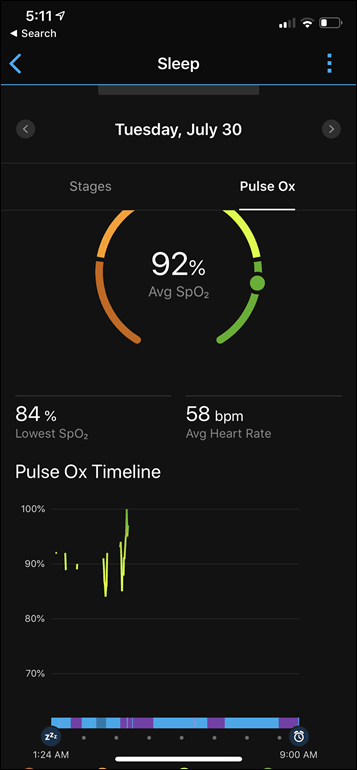
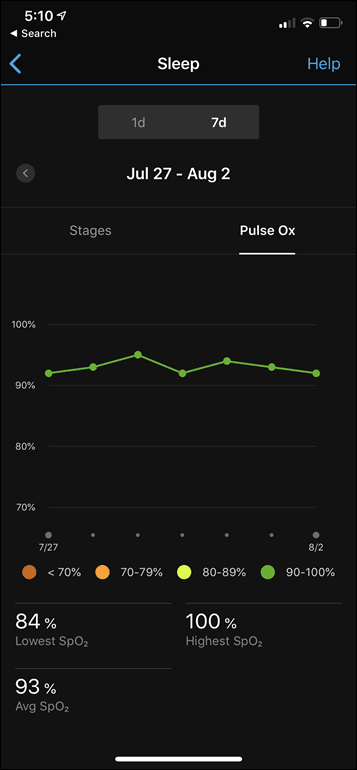
En outre, toutes vos statistiques d'activité quotidienne, comme les marches, les escaliers, la distance parcourue, etc., sont également présentes dans l'application, ainsi qu'en ligne sur le site Web:
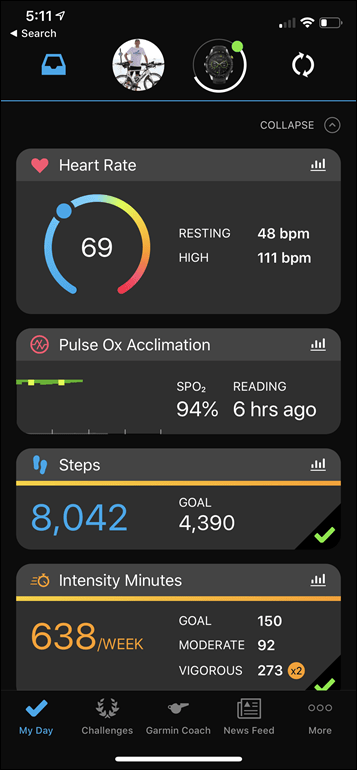
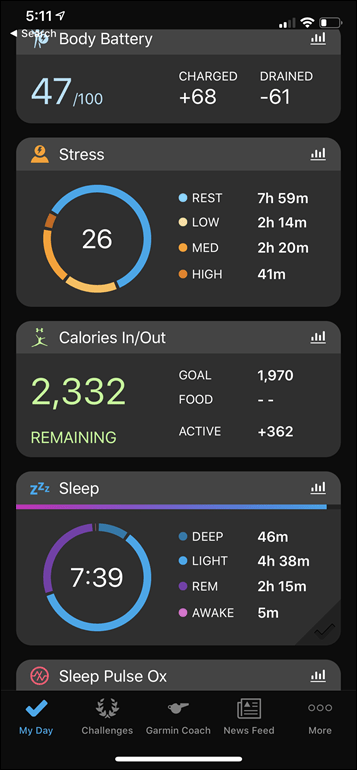
Les mesures plus récentes que l'on trouve sur les appareils Garmin les plus récents y sont également présentées – comme Body Battery, qui vise à quantifier le mélange de sommeil, de stress et d'activité ensemble.
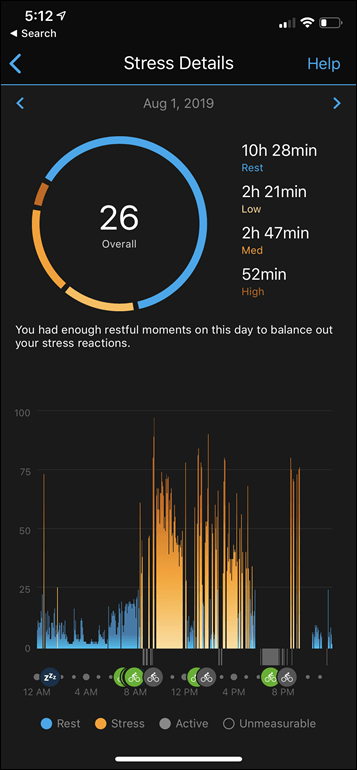
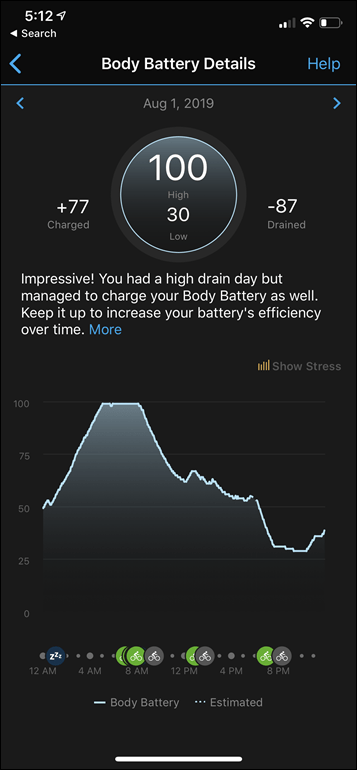
L'application Agenda affiche les entraînements démarrés manuellement ainsi que les exercices détectés automatiquement. Par exemple, ma course d'hier était un entraînement commencé manuellement, alors que les nombreuses balades à vélo autour de la ville entre le bureau et la maison étaient automatiquement détectées:
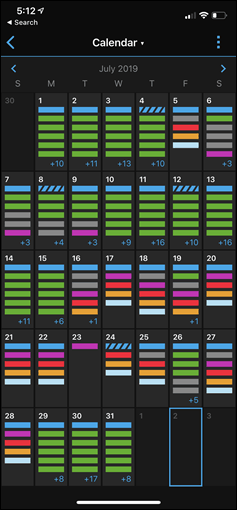
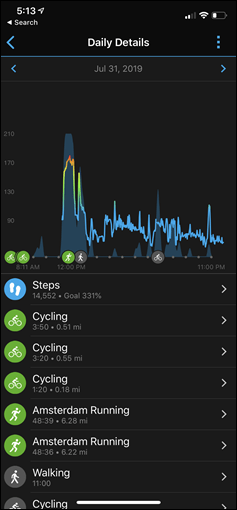
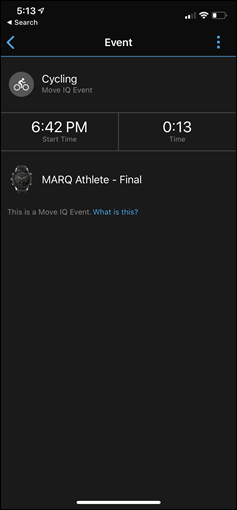
Enfin, une dernière chose à aborder brièvement concerne les notifications. Toutes les montres afficheront les notifications de smartphone sous iOS et Android. Vous pouvez les contrôler via les centres de notification des deux plates-formes. Les notifications sont simplistes et ne sont pas du même niveau que la Apple Watch en termes d'images ou autres (mais certains emoji apparaissent):
Notez qu'avec un appareil iOS, vous ne pouvez pas répondre / répondre aux notifications en raison de restrictions imposées par / de Apple (qui n'autorise pas les tierces parties à accéder aux messages texte). Ma compréhension est sur Android, mais vous pouvez répondre à partir de la montre elle-même.
Ok, avec ça, je pense que nous avons couvert toutes les bases, il est maintenant temps de devenir sportif.
Spécificités sportives et d'entraînement:
Un peu étrange, lorsque la série MARQ a été annoncée pour la première fois, nous ne connaissions pas beaucoup des nouvelles fonctionnalités de fitness qui se cachaient sous la surface. Bien sûr, quelques allusions à des changements étaient visibles – mais toute l'histoire a mis un mois ou deux à s'éclairer, à peu près au moment du lancement du Garmin Forerunner 945. C’est à ce moment que l’ensemble des nouvelles fonctionnalités axées sur la physionomie est devenu beaucoup plus clair et que les différences avec la série Fenix 5/5 Plus sont devenues plus marquées.
Par exemple, toutes les fonctionnalités suivantes axées sur la condition physique sont au-dessus / au-delà de la série Fenix 5 Plus (elles le sont également sur le Forerunner 945):
– Ajout de statistiques sur la charge d'entraînement
– Ajout de détails / mesures d'effets d'entraînement plus approfondis
– Acclimatation à la chaleur ajoutée (pour tous les entraînements dont la température est supérieure à 21 ° C / 71 ° F)
– Ajout de l'acclimatation d'altitude (à tout moment ou séances d'entraînement passées au-dessus de 850m
– Ajout de la détection d'incident (si vous écrasez votre vélo, il en avertit quelqu'un)
– Taux de respiration ajouté (avec une ceinture pectorale)
– Ajout de la sécurité / assistance de suivi (vous pouvez appuyer sur le bouton pour envoyer une alerte d'aide à vos amis / famille)
– Un prédicteur de course réorganisé pour être un peu plus strict sur les prédictions (plus que de simples tableaux de recherche VO2Max)
– VO2Max compense maintenant la chaleur (ce n’était pas le cas auparavant)
– Le statut de formation compense maintenant la chaleur (ce n’était pas le cas auparavant)
– Ajout du capteur PulseOx (auparavant uniquement sur Fenix 5X Plus)
Et pour être honnête, si vous ajoutiez en haut de la liste "capteur GPS modifié à Sony", vous auriez en fait la totalité des modifications apportées à la série Fenix 5 Plus, car toutes les autres modifications apportées au MARQ sont spécifiques aux matériaux et plus esthétiques. dans la nature. En fin de compte, si vous résumez toute cette analyse, la seule différence entre un athlète MARQ et un Forerunner 945 beaucoup moins cher (et plastique) réside dans les matériaux (et la durée de vie de la batterie, qui sont davantage basés sur le FR945). Toutes les fonctionnalités logicielles axées sur le sport sont identiques, à l'exception de quelques modes supplémentaires tels que Jumpmaster et Tactical, inspirés des jours précédents de Fenix / Tactix.
Commençons donc par le début, et cela commence par le choix d’un sport. Pour ce faire, appuyez simplement sur le bouton supérieur droit pour afficher les modes sportifs. Une fois que vous avez appuyé sur ce bouton, l'appareil commencera à rechercher le GPS, même avant de sélectionner un sport en plein air. Il essaie de faire un saut dans la tâche à accomplir.
There are numerous sport modes available (which technically speaking are apps). Some sports have super detailed metrics, whereas others are a bit more bland. For example the detail and focus on running and cycling is strong. But if you go to kayaking or rowing, you’ll get overall metrics just fine, but not things like paddling rates. So again, it varies. In any case, here’s the complete sporting listing:
Trail Run, Run, Hike, Bike, Bike Indoor, Open Water Swim, Triathlon, Golf, Navigate, Track Me, Map, Multisport, Treadmill, Indoor Track, Climb, MTB, Pool Swim, Ski, Snowboard, XC Ski, SUP, Row, Row Indoor, TruSwing (Golf related), Project Waypoint, Walk, SwimRun, Kayak, Strength, Cardio, Yoga, Floor Climb, Elliptical, Stair Stepper, Clocks, Boat, Tactical, Jumpmaster, Other [Custom]
You can iterate through the list by simply pressing up/down, as well as add sports to your favorites section (for quicker access). One minor nuance is that I’ve found it somewhat easy to randomly end up in the sport selection menu (pending me waiting to actually select a sport). For example as I went through security the other day at the airport I came out the other side and found my watch on the sport selection screen (whereby it’s burning GPS time already).
This is likely because the larger yellow selector button butts right up against my wrist bone, and is more easily accidentally pressed. While the menu will time-out automatically after a few mins, I find myself on this menu multiple times per day somehow.
Once you’ve picked a mode for your sweat session, it’ll complete finding GPS, as well as connect to any sensors (such as heart rate monitors or cycling sensors). The MARQ series supports all the same sensors as the Fenix 5 series and the FR9945 did, including Bluetooth Smart sensors as well. There’s no additional/new sensor types support here. Here’s the full listing of sensor types it supports:
Headphones (Bluetooth), External Heart Rate (ANT+/Bluetooth Smart), Speed/Cadence (ANT+/Bluetooth Smart), Cycling Power Meters (ANT+/Bluetooth Smart), Footpods (ANT+/Bluetooth Smart), VIRB Action Camera (ANT+), Tempe temperature sensor (ANT+), Shimano Di2 (private-ANT), Cycling Gear Shifting (ANT+), Cycling Lights (ANT+), Cycling Radar (ANT+), Extended Display (ANT+), RD Pod (ANT+), Muscle O2 (ANT+), Garmin inReach (ANT+).
So basically, anything and everything you could want. Also, it supports Garmin’s ‘Xero’ lineup of range finders/sights (you add those in a slightly different spot). The only notable exception to the list above is cycling ANT+ FE-C trainers, which are not connectable here (but are using Garmin’s Edge devices).
You can save/connect multiple sensors of the same type. For example, if you have multiple bikes, each with their own cadence sensors on them, it’ll save those and automatically connect to them when those sensors turn on. Additionally, via data fields and apps, companies can create their own sensor types. We’ve seen companies create tire pressure sensors and aero sensors.
Note that sensors are across the entire device. So you define sensors and all activity profiles/sports can use them. I’ve saved numerous sensors to my watch, and if I’ve got two sensors active that ‘conflict’ (like two HR straps nearby), it’ll simply ask which one to use.
Speaking of those sports above, each one is customizable with unique data pages/metrics, and settings. All of these screens are customizable, and you can create/add new pages/screens as you see fit (a crapton of them, more than I could create). There are also stock screens with certain data types, including Virtual Partner, Compass, Elevation, Map, and Music controls.
However, custom data pages can have up to four data fields on them, in a variety of patterns. You can choose the pattern and then choose the individual data fields to add to those pages. Here’s a gallery of different page looks:
Like I said in the Forerunner 945 review, I’d like to see Garmin allow users to put more data on these screens. Especially when looking at the larger MARQ screen. After all, Suunto allows significantly more data on their custom pages. And while you can download some 3rd party Connect IQ app data fields that do such things, that’s quite frankly cumbersome. There’s no good reason to limit it to 4 data fields per page on such a large screen.
Now that we’ve spent half our life setting things up (in reality, you don’t need to do anything above I noted, you can just press start and go), it’s time to begin our workout. Just press the start button again and it’ll start recording and displaying your metrics. Here’s a quick look at what some of those metrics look like in yet another gallery. You can never have enough galleries:
With everything cooking along you’ll be out running, riding, or what-not. For a sport like running, I saw no issues with pace stability. It reacted just fine to my changes/shifts in pace. I’m usually looking for quick responsiveness when doing something like a track workout, yet more stability on a longer run. Either way, that hasn’t been a problem for me (or perhaps I’m just a stable runner).
Note that the MARQ series does include incident detection (as well as safety alerts if you are in an situation where you want to quickly notify friends/family something might be up). Where incident detection is basically if you crash while riding your bike, it’ll trigger. The unit is essentially looking for a high g-force type event followed by nothing. Meaning, merely landing a jump hard shouldn’t trigger it, but rather crash-landing a jump and then having your speed go to zero will likely trigger it.
In practice, I have had one false positive while riding (and then another false positive on the FR945, which employs identical tech). In the case of the FR945 I understand why it triggered (I was riding along and dropped off a sidewalk and then immediately stopped quickly at a stop-light). But with the singular MARQ false-positive I was happily riding along in the Alps and it just randomly triggered. Mind you, this is like nearly 5 months of riding with it and only having it false-positive trigger once isn’t the end of the world. You’ve got 10 seconds to cancel it (though that can be tricky to do while mid-descent). You can tweak who it contacts and how it works in the settings of both the device and the app:
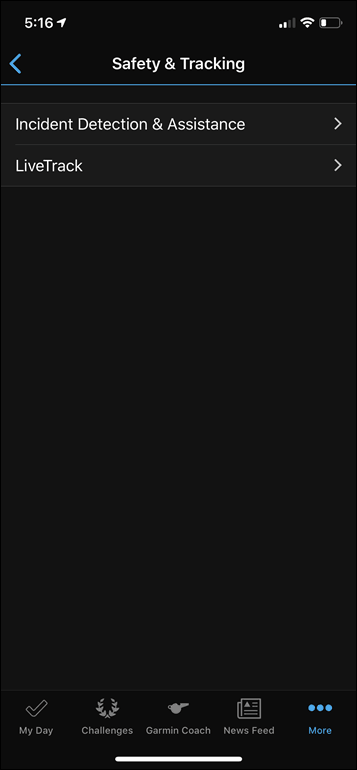
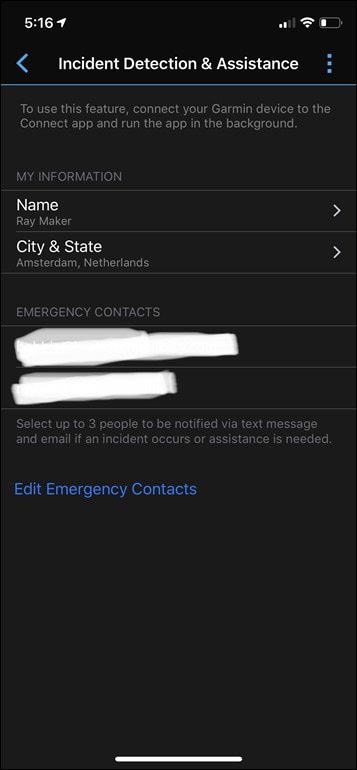
Once you’ve completed your workout (by pressing stop, then save) you’re going to see the new post-workout screens. These start by showing a quick outline of your route if outdoors, and some high-level stats. It’s divided up into a rotating upper portion that lists Summary, Training Effect, VO2Max & Recovery, and Training Status.
Then lower down you’ll get more detailed stats about different areas, such as laps or a map or training effect.
It’s within these Recovery & Training Status bits that you’ll start to see some of the new features that were also launched on the FR945 this past spring. First is that there’s new Training Effect details and labels. Training Effect itself has been around a long time on Garmin watches/bike computers, but now it’ll list the exact training benefit of each workout you do. For example my ride last night it shows the training load (181) at the bottom, and the specific benefit up (Threshold) top in orange. You’ll also see the breakout between anaerobic vs aerobic listed too).
If I press the down button, I’ll then get a tiny bit more detail for both aerobic and anaerobic, each on separate screens. It’ll indicate exactly what within each of those two classes it was benefiting.
But for a lot of folks the above detail wasn’t super helpful. It’s kinda just noise for the average athlete. So within the FR945/MARQ series you’ll now get more specific training status details for fitness and load. This basically tells you whether your fitness is improving or decline (or maintaining), and then what your load is doing (up/down/maintaining).
If you press down you’ll get a 7-day load widget, showing you the types of load and the amount of load you accumulated each day. Additionally it’ll list the optimal range of load for you, based on your current load. Meaning that if you’ve just started training and it’ll keep that load lower, versus if you’re pumping out 10-12 hour weeks each week – you’ll see that be higher.
As usual with these sorts of metrics, you’re really looking at about a four week timeframe until it really starts to learn you. And in fact, the next page is geared exactly towards that. This page will show your four week load focus, including these little pill icons that basically show you whether each load type is balanced correctly. Thus if you’ve got too much high intensity load versus not, it’ll indicate that. Like eating, varying intensity in your workout diet is important. Simply doing a hard workout every time isn’t the path to getting faster.
In fact, if you press the enter button it’ll tell you exactly how you should tweak your training diet to better align things:
After that the next page shows your current recovery time. In general this is for your next ‘hard workout’ and not just the next workout in general. I’ve always somewhat taken this number with a grain of salt, and usually find it a bit too conservative.
After that, I’ve got altitude acclimation, which is on both the FR945 and MARQ. The goal behind both of these are post-workout calculations tied to figuring out whether or not you’re acclimated to a given temperature or altitude. Obviously, both can significantly impact performance. Starting with heat acclimation, the function leverages nearby weather stations. So your unit has to have connected to Garmin Connect Mobile within 3 hours of starting your ride in order to receive that weather data (it doesn’t use on-device temperature).
You’ll see small icons on the bottom of the training status page if you’re in the midst of acclimating to anything. In the case of below last week, I managed to score both heat and altitude acclimation icons at the bottom:
Altitude acclimation/adaption starts with a minimum threshold at altitudes above 850m/2,788ft, and tops out at 4,000m/13,123ft (Garmin doesn’t calculate above that level, sorry folks). Garmin says that they divide up training vs living altitudes, just as typical studies would. The company says that adaptation algorithms within the MARQ/Forerunner 945/Edge 530/830 assume total adaptation after 21 days, and that adaptation is faster at the beginning of altitude exposure. Additionally, adaptation will decay within 21-28 days depending on acclimation level.
Fun geekery moment for you: On the Forerunner 945/MARQ, the altitude acclimation is based both on workouts, but also on where you sleep each night. At midnight the unit will quietly take an altitude reading (actually, it’s doing it all the time anyway), and then use that reading to determine acclimation. Where this gets fun is when you take redeye flights, as it’ll take that reading at between 6,000-8,000ft (pressurized cabin altitude of a commercial airliner). At first you may think this would skew results, but in reality – it’s actually correct. Your body is acclimating to that altitude. Where it’s slightly off is that it assumes you’re spending 24 hours at that altitude, rather than the 5-14 hours you’re likely spending at that elevation.
Meanwhile, the next screen is heat acclimation.
For heat acclimation it applies a heat correction factor for rides above 71°F/22°C, using a percentage based amount from published studies (humidity is also factored into this as well). This is then shown in the training status widget. Garmin says they assume full acclimation takes a le minimum of 4 days, and acclimation/adaptation to a given high temperature will automatically decay after 3 days of skipped training within that heat level.
Some of this is available within the Garmin Connect Mobile app, but it’s messy and scattered at best. For example, here’s the Training Effect pages (under Performance stats, but not the self-titled ‘Training Stats’ section) – but this is missing the matching color coding of the device itself (no purple here):
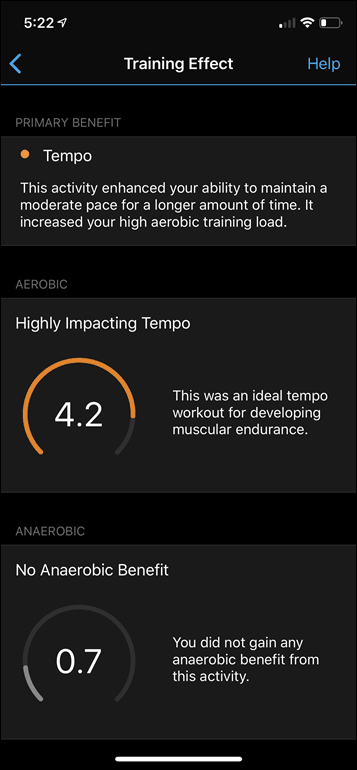
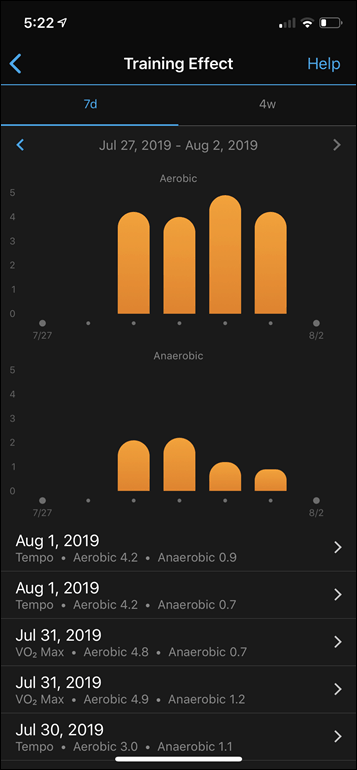
However, the ‘Training Status’ section gets you a bit closer. Showing altitude acclimation as well as heat acclimation. But there’s still weird gaps. For example the ‘Load’ metric on the screen is missing a value on the main page. Though, it does do an interesting job at dividing up whether any given week was productive or not.

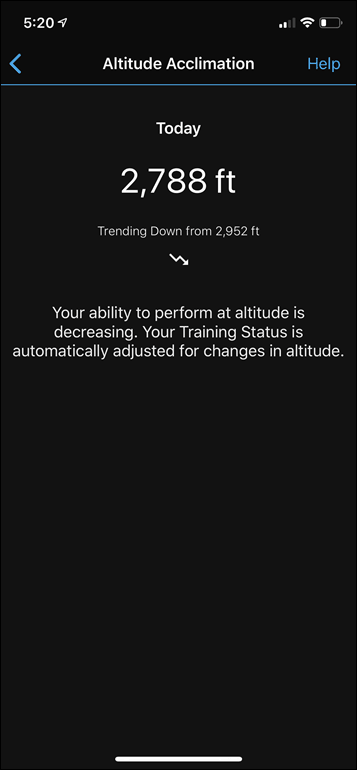
In any event, re-winding a little bit to where we left off post-workout, the workouts are automatically synced to Garmin Connect via Bluetooth to your phone or WiFi if you’ve configured that. From there you can open it on Garmin Connect Mobile:
Or, on Garmin Connect itself. Here’s a recent workout of mine from last night if you want to poke around by clicking on the link:
In addition, at the same moment these activities are sent to any 3rd parties that you’ve connected to your account, like Strava or TrainingPeaks, among many others. At which point, we’ve covered how everything works from a sport specific standpoint. Of course, there’s countless nuances to other metrics you can dive into like VO2Max (which now accounts for heat), or stress tracking via HRV data.
Now switching very briefly to swimming is that as of today, in the official production firmware, Garmin doesn’t leverage the optical HR sensor while swimming, whereas Polar and Suunto do. But that’s already changing in beta builds for the FR945, and likely soon the MARQ too. Whether or not it’s accurate will vary (even Polar & Suunto admit it’s a bit variable).
In the meantime, you’ll need either the HRM-TRI or HRM-SWIM HR straps. These straps will capture data while swimming, and then download it after the swim to your watch, merging the data together.
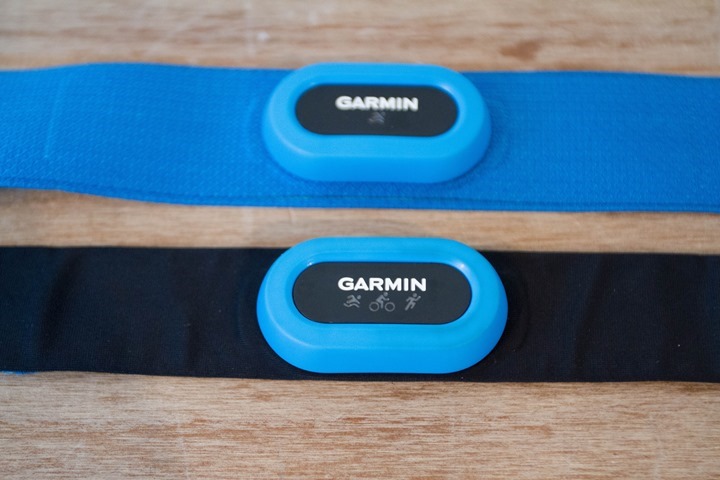
The HRM-SWIM strap is designed for pool swims (it has a sticky surface on the back that holds well for flip/tumble turns). The downside to the much larger blue HRM-SWIM is that it’s not very comfortable out of the water, such as running. Whereas the HRM-TRI is designed primarily for openwater swims worn under a tri suit as it doesn’t have the stickiness, but is more akin to a regular HR strap that feels normal when out of the water running or riding.
The catch with both straps is that you can’t see your HR live in the pool, as the digital signal won’t go through water (only analog signals will, and even Polar’s latest Vantage series doesn’t support that anymore). The other catch to both straps is that they’re ANT+ only, unlike the new HRM-DUAL strap that has ANT+ & Bluetooth Smart. So you’re kinda in a pickle. Undoubtedly Garmin will eventually upgrade the HRM-TRI/SWIM with dual ANT+/Bluetooth, though it doesn’t sound like that’s going to happen immediately. Just sucks to buy something that’s basically so limited. Though frankly, if you want HR data this season, you’ve really only got one choice.
Finally, I want to briefly touch on maps. I discuss this far more extensively in my Fenix 5 Plus review (mapping/navigation/ClimbPro section here), where the features/functions are identical. But, all MARQ units have detailed maps for the region they were bought in. So if you bought the unit in Europe, you’ll have European maps, and in the US, North American maps. Etc. These maps include digital elevation data as well within them.
What’s frustrating to me though is that here’s MARQ at $1,500 and yet you still have to either pay Garmin, or go through the cumbersome process of downloading 3rd party maps for travel outside your region. I mean, this is a watch that’s pitched at a person that is likely to travel internationally. And if you take a US watch on a European trip, those US maps are totally useless in Europe. Here was the one opportunity for Garmin to offer a singular and unique premium software feature on MARQ not found on the FR945 (which is 1/3rd the price), and they missed it.
You can move around the map using the upper right button, which iterates between zoom/pan/scroll. This allows you to both see the terrain around you, as well as navigate to points of interest or other places. For example, there’s a full POI (points of interest) database on the unit, so you can find nearby restaurants, monuments, lodging, geographic points, and a slew of other spots. Functionally this is useful if perhaps you’re hiking and want to know how far it might be to a campsite or food, or to a given landmark.
You can also create ‘Round-Trip Courses’ for both running and cycling that allow you to set a given distance and desired direction of travel (if you want) and it’ll come up with a course using the internal heatmap data (aka ‘Trendline Popularity Routing’ data). It takes about 1-3 minutes (kinda a long time) and comes up with three differences courses. No internet connection is required for this.
Finally, you can follow any downloaded courses as well, using Garmin’s new (albeit cumbersome and horrifically slow) smartphone course creator, or any other downloaded GPS files:
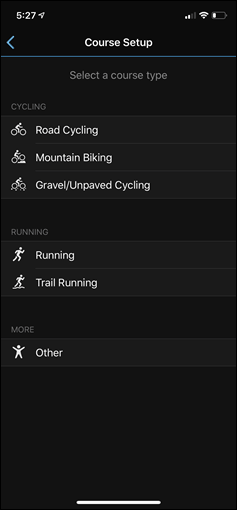

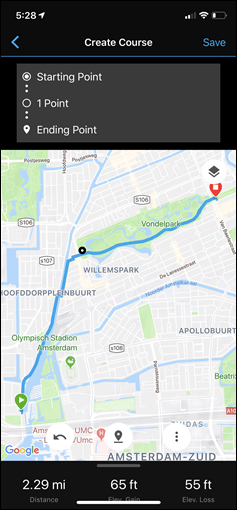
Once following these routes, you’ll get instructions on when to turn, and when you’re off-route. The value of having the underlying map data becomes clear when you’re at an intersection of multiple trails and trying to have context of what’s around you. Previously with a non-mapping unit you had breadcrumb trails but it was just over a grey background of nothingness. Now you can see that you’re along a river, or going towards a mountain. Or just near an donut shop. Whatever’s important in life.
Music & Garmin Pay:
The MARQ Athlete includes both on-board music storage and Garmin Pay. The music bits can be used to storage regular music files (like MP3’s), but also to cache music from streaming services including Spotify and Deezer. This allows you playback music to Bluetooth headphones without your phone. So you can head out for a run and listen to any cached Spotify (or other platform) music you’ve downloaded ahead of time.
I’ve detailed how music works extensively in numerous posts, and when it comes to the MARQ Athlete, it’s all the same as Garmin’s other watches (mainly mirroring that of the Fenix 5 Plus/FR945 variants). For example, if you want Spotify, here’s an in-depth piece on how that works.
In my case, I largely used Spotify with the MARQ, since that’s my primary streaming platform for the rest of my life. Setup only takes a few seconds, and then it’ll allow you to choose which playlists, albums, or even podcasts to download. Downloading occurs via WiFi, so you need to have that handy in order to get streaming music onto the device. Whereas for regular MP3 files you can drag/drop those on manually.
You’ll need some sort of Bluetooth audio device to playback the music. There’s no playback speaker (or microphone) on the MARQ Athlete (or any other Garmin watch for that matter). In my case I’ve used a variety of headphones including the AirPods, PowerBeats Pro, Jaybird Vista, and an older PowerBeats headphone. All of them have largely worked great for me.
Garmin has made specific improvements around audio connectivity in each successive product since their first music-enabled watches in early 2018. So if the last time you tried music was on a Garmin Forerunner 645 Music, the company has learned a lot in that timeframe (just as Apple has as well around improving compatibility with things like the AirPods). Bluetooth connectivity between power-limited wearables has always been tough, but it’s largely good and transparent on the MARQ series.
Playback is easy and you can do so from either inside or outside a workout, including music controls. Additionally you can add in audio prompts/overlays for stuff like laps and heart rate alerts:
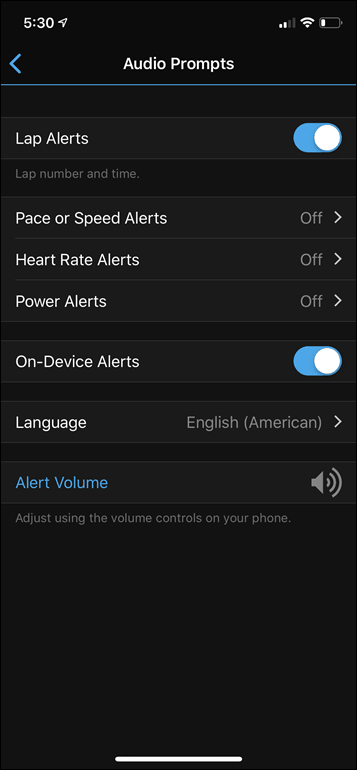
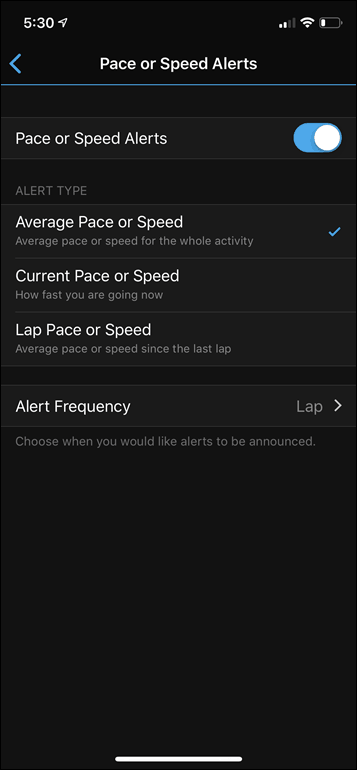
Meanwhile, on the Garmin Pay side, this allows you to load supported bank cards onto the watch and then simply tap to pay at retailers that support it. This isn’t tied to Visa or Mastercard per se, but rather to individual banks that Garmin has setup ties with to load onto the watch. A few years ago this was fairly limited, but these days it supports most of the major credit card companies in the US, and many top international banks as well. But it really varies by country. For example all of my US credit cards are supported, but neither my French HSBC or Netherlands ING is supported yet. Full listing of banks is here (it changes often). Given ING just finally lit up on Apple Watch in the last month or so, I suspect we’ll see it soon on Garmin too.
Loading up a card is pretty quick and easy, assuming your bank is supported. As part of loading it onto your watch it’ll have you create a PIN. If you want to perform a Garmin Pay transaction it’ll ask for you pin (just like it would on your phone).
However, the watch is smart enough that once you’ve entered in your pin it’ll save it for 24 hours as long as you don’t take the watch off your wrist. In other words – the same as Apple or Fitbit. You can also create a hotkey shortcut to access the Garmin Pay menu more quickly if you want (by long-holding a given button of your choice). Once you’ve opened up the wallet/card it’ll give you a timer to tap it on the payment surface.
It’ll complete the transaction in a second or two and then you’re on your way. These days as long as the retailer supports contactless payments, everything largely ‘just works’, and that’s true with the MARQ and payments as well.
GPS Accuracy:
There’s likely no topic that stirs as much discussion and passion as GPS accuracy. A watch could fall apart and give you dire electrical shocks while doing so, but if it shows you on the wrong side of the road? Oh hell no, bring on the fury of the internet!
GPS accuracy can be looked at in a number of different ways, but I prefer to look at it using a number of devices in real-world scenarios across a vast number of activities. I use 2-6 other devices at once, trying to get a clear picture of how a given set of devices handles conditions on a certain day. Conditions include everything from tree/building cover to weather.
Over the years I’ve continued to tweak my GPS testing methodology. For example, I try to not place two units next to each other on my wrists, as that can impact signal. If I do so, I’ll put a thin fabric spacer of about 1”/3cm between them (I didn’t do that on any of my MARQ workouts). But often I’ll simply carry other units by the straps, or attach them to the shoulder straps of my hydration backpack. Plus, wearing multiple watches on the same wrist is well known to impact optical HR accuracy.
Next, as noted, I use just my daily training routes. Using a single route over and over again isn’t really indicative of real-world conditions, it’s just indicative of one trail. The workouts you see here are just my normal daily workouts.
I’ve had quite a bit of variety of terrain within the time period MARQ Athlete testing. This has included runs in: Paris, Amsterdam, Kansas, Mallorca (Spain), Canada, Greece, California, and plenty more I can’t remember at this point. We’re talking nearly 5 months of testing. Cities and countryside, mountains, trees and open-air. It’s been everywhere!
All of the workouts you see here I did with Galileo enabled, mostly because I was curious how well it would perform given it was new.
First up we’ll start with a run through Amsterdam two days ago. In this rare case I only had a single other device, but I’m including it since it’s only two days old and with this particular route it’s silly easy to confirm where I was and wasn’t from a path standpoint (versus hiking in the wilderness somewhere). Here’s the full data set:
Things started off a bit rough for both watches. Somewhat unusual in this perfectly straight spot:
But they did settle out a few minutes later and straighten up:
Some 5-10 minutes down the road I entered Vondelpark, and the MARQ handled it OK. Not great, but OK I guess. The FR945 seemed to be having a bad day with anything resembling basic tree cover. You can see it continued to lose the plot and cut through trees and buildings. Note this was a super simple test with only a single watch on each wrist.
Now above you’ll see that MARQ was hardly great. In fact, I wouldn’t even grade this ‘good’. I’d say it was more of a ‘sigh’.
And as I continued towards the end of the park, the results from both watches were blah at best. This is the new Sony chipset at work here, and unfortunately what every GPS fitness company have gone to in 2019.
Sure, it’ll get better, but this is also the reality too. Some days are great (as I’ll show), and some days are crap, like above. And some days two watches using identical chipsets and near identical firmware on two different wrists produce dramatically different results for the same stretch of road as seen below:
Next, let’s switch over to doing loops around in Newfoundland, Canada in the woods. These trees weren’t crazy high or anything, but it’s a good test of correct positioning nonetheless:
Now I know the above/below can be a bit hard to see, but the key thing to look for is the red line. That’s not the MARQ, but the Polar. And it’s always off in the trees. The MARQ and FR945 are actually largely on the trail or within a meter or two of it.
Though, all watches, including the Polar Ignite and MARQ did quite well on this brief out and back section when I left the woods and stumbled into a neighborhood. Including most notably staying on the outer edge of this cul-de-sac:
But I’ve actually go no complaints about the MARQ (or FR945) on this particular tree-laden effort.
So let’s zip back across the pond to Paris. Sure, this run was in early June and GPS has improved slightly since then. But still, it’s not to shabby. This was against a FR945 and a COROS Vertix beta unit. The Vertix launch was delayed to deal with continued GPS accuracy issues, like this track shows.
The MARQ (and FR945) handled the start of the run pretty well. This is a section I’ve run countless times down (and up) Boulevard Saint-Michael. It’s not easy for GPS because it’s only 3 lanes wide but as taller 6-8 story buildings on both sides. But the watches color in the lines:
And in fact, the MARQ was the only watch of the three to correctly nail my actual route through the Louvre, including cutting through the tunnels in correct spots.
And the remainder of the run along the river was fairly good too (for both MARQ and FR945). As I neared the Eiffel Tower the MARQ was also the better of the two there as well. Minor differences, but technically more correct.
Now let’s shift over to a quick ride. Well, a quick review of the ride. The reality is that for road bike riding most GPS units handle it fairly well, and this was no different. Here’s that overview/data set:
Zooming into some of the forested bike path section for the fun of it:
You’ll see that the MARQ (along with the Edge 530 & Stages L50) do just fine. Whereas the Polar Ignite GPS cuts the corners a bit. Other times though all units easily make the corners, even under some relatively significant 4+ lane highway overpasses that this little zig-zag goes under.
Ultimately, the MARQ GPS accuracy ranges between ‘blah’ and ‘perfectly fine’. It just depends on the day, though sometimes less so on the circumstances. Sometimes I think that the unit actually performs better in harder spots (Central Paris), and then stumbles in easier spots like Vondelpark in Amsterdam. Then again, the same can be said for many GPS units.
The thing is that this point in 2019, everyone’s going to be on Sony for new units. So anything announced in 2019 (and most things non-Garmin announced in 2018) are running the Sony chipset. Be it Polar, Suunto, or Garmin (I haven’t seen anyone pin down what chipset Apple uses for the Apple Watch, but frankly it doesn’t matter – GPS accuracy on land is worse there), you’re gonna end up with a Sony chipset. And while all these companies are pressuring Sony to get better, the results are still kinda variable. There are good days and bad days, and there’s not a lot we can do about that.
One can try and find whether Galileo or GLONASS works better for your routes/area, though I suspect we’ll see Garmin shift their focus more to Galileo in the near to medium term, which should ultimately help across the board. I’ve used both modes and it’s hard to see a specific pattern at this point.
Note that I did have one epic openwater swimming failure back in May, which ultimately was a core driver for this post. Garmin says as of last week they continue to make progress on openwater swim across all units, with another openwater swim focused GPS beta due in the next week or two. They say they’ve been sending out lots of employees into the waters around Olathe to constantly test and try and eradicate the issues I and others have had. And for my part, I’ve lucked out on recent MARQ swims with them actually nailing it (really well).
With the openwater swim issues, it’s either zero or hero. Littéralement. Either you’ll have a great GPS track or you’ll record virtually nothing (as in, like a few dozen meters). There’s no in between. While Garmin has said they wanted to solve this by the end of June initially, I think the more realistic timeframe is the end of ‘summer’. Either way, we’ll see.
(Note: All of the charts in these accuracy portions were created using the DCR Analyzer tool. It allows you to compare power meters/trainers, heart rate, cadence, speed/pace, GPS tracks and plenty more. You can use it as well for your own gadget comparisons, more details here.)
HR Accuracy:
Before we move on to the test results, note that optical HR sensor accuracy is rather varied from individual to individual. Aspects such as skin color, hair density, and position can impact accuracy. Position, and how the band is worn, are *the most important* pieces. A unit with an optical HR sensor should be snug. It doesn’t need to leave marks, but you shouldn’t be able to slide a finger under the band (at least during workouts). You can wear it a tiny bit looser the rest of the day.
Ok, so in my testing, I simply use the watch throughout my normal workouts. Those workouts include a wide variety of intensities and conditions, making them great for accuracy testing. I’ve got steady runs, interval workouts on both bike and running, as well as tempo runs and rides – and even running up and down a mountain.
For each test, I’m wearing additional devices, usually 3-4 in total, which capture data from other sensors. Typically I’d wear a chest strap (usually the Garmin HRM-DUAL), as well as another optical HR sensor watch on the other arm (primarily the Polar OH1+, but occasionally the Wahoo TICKR FIT, and Scosche 24 too). Note that the numbers you see in the upper right corner are *not* the averages, but rather just the exact point my mouse is sitting over. Note all this data is analyzed using the DCR Analyzer, details here.
Note that while I’ve been using the MARQ Athlete since late February, I’m mostly going to use the most recent data in this review – since that’s the firmware that it’s currently on and the production firmware that real world people are using. So let’s start with my ride from last night. Simple road cycling prior to sunset around the countryside with a friend. Nothing crazy intensity or temperature wise, just a nice ride. Data set here.
That teal line is the Garmin MARQ. It’s the one that sticks out the most as least like the others. The others being the Garmin HRM-DUAL chest strap, the Polar OH-1 Plus optical HR sensor, and the Polar Ignite GPS watch (with optical HR sensor). That said, cycling outdoors is typically one of the most challenging things for wrist-based optical HR sensors, primarily in any shifts in intensity.
And that’s what we see above/below. During relatively steady-state time (the vast majority of the workout), the HR’s are nearly identical. But in cases where I shifted intensity, that’s where things are delayed or otherwise fall apart. And you can see that below in this zoomed in section where we were shifting intensity a bit and things went askew.
But the vast majority of the ride things were generally within 1-2BPM of the rest of the sensors.
What happens though if we slide indoors and get rid of the wobble of outside roads? Ask and you shall receive. Here’s an indoor trainer workout from Wednesday where it was basically just put ones head down and pedal through the intervals. Data set here:
You can see the MARQ stumbles briefly at about the two minute marker, but then is mostly pretty good. There’s a point around the 15 minute marker where I do a calibration (which requires my hands) that causes the MARQ some confusion. But by and large it handles things pretty good. Even the harder intervals it nails:
Ultimately, I don’t really have much in the way of complaints above.
Next, let’s transition to a run from two days prior, this one around Amsterdam. Again, nothing too crazy here either, though it was raining buckets out. Usually rain isn’t an issue for optical HR sensors (whereas swimming can be). Here’s that data set:
The above was a relatively steady run, and you can see that for the most part things were fairly good. A bit of wobble around the 26-30 minute markers though, where we see some moderate separation from reality.
To the best of my knowledge I wasn’t doing anything funky here, since at this point my camera battery has sadly long since died. There’s no real good reason for the separation. Though, I suspect the reason is more simple: The MARQ is a heavy watch, and as such it ‘bounces’ a bit more – even when nice and tight and snug. Universally heavier watches (be it Garmin, Suunto, or otherwise) do more poorly with optical HR sensors on the wrist than lighter watches. A well established fact. And there are elements of that likely shining through here.
Still, let’s shift to a nice interval workout. This one’s got some great data against the Polar Ignite GPS watch, Polar OH-1 Plus optical HR sensor, and the Garmin HRM-DUAL. Here’s the full set:
As you an see, everything starts off fairly good. A nice steady build, and in fact I’d argue the MARQ probably nailed this the most correct out of everyone:
After that point, all the watches easily handle my gradual build period. No issues. As I go through some initial casual intensity shifts, we see the MARQ lag a little bit compared to the rest. Just a couple seconds, and something you’d be unlikely to notice if just carrying a single device.
This is a pattern we’d see continue slightly into the first interval, though the unit mostly nailed the 2nd/3rd/4th intervals. So not too shabby actually.
As I shift into some 60-second long intervals below you’ll see that the MARQ does lag a few seconds, though so do the other optical HR sensors. Only the traditional chest strap HRM-DUAL didn’t have any lag. that’s not super unusual, but it’s not always the case either. Just sorta depends on the day. There are plenty of cases (especially in cooler/dryer temps) where an optical HR sensor will handle better.
Ultimately though, I suspect most people wouldn’t have noticed any differences between MARQ and their regular HR sensor on this interval run. And it’s pretty unlikely any coaches would have well. A few seconds delay isn’t something that really matters for HR to most people. What tends to matter is major misses and spikes/dropouts.
Essentially the MARQ follows along with most of Garmin’s other wearables. I find it generally fine for me (when worn correctly) for most runs, even intervals. Whereas I find for outdoor cycling it’s usually non-ideal, and for indoor cycling it’s mostly OK. This rough overview hasn’t really changed much for Garmin in the last few years. But they do make progress on it each year. Fixing an outlier here and an outlier there, slowly but surely making it better. Which is probably why I’m able to run intervals with the Garmin ELEVATE V3 sensor (used in MARQ) now, whereas that wasn’t always the case a few years ago.
Comparaison de produits:
I’ve added the MARQ Athlete into the product comparison tool, which allows you to compare it against any watches I’ve reviewed to date.
For the purposes of the below table, I’ve compared it against the existing Fenix 5 Plus, Forerunner 945, Suunto 9 (I thought about adding the Polar Vantage V, but looks wise it’s not really competing here). Realistically though, my tables don’t capture data points like ‘swanky band’ or ‘fancy looking bezel’. So looking purely at this chart you’d come away with the (mostly correct) impression that there’s no difference between a FR945 and a MARQ Athlete watch.
Still, from a features standpoint you can easily mix and match against any other products within the database here, by creating your own product comparison tables. Note that in some cases nuanced features (like being able to calibrate altitude based on the map DEM data), doesn’t really fit well into product comparison tools designed to host hundreds of watches (when only a single watch has it).
| Fonction / Caractéristique | Garmin MARQ Athlete | Garmin Fenix 5 Plus (5/5S/5X) | Garmin Forerunner 945 | Suunto 9 Baro |
|---|---|---|---|---|
| Copyright DC Rainmaker – Updated August 2nd, 2019 @ 10:27 amNew Window | ||||
| Prix | $1500 | $699/699EUR | $599/599EUR | $599 (non-baro is $499) |
| Product Announcement Date | March 13th, 2019 | June 17th, 2018 | Apr 30th, 2019 | June 5th, 2018 |
| Actual Availability/Shipping Date | Avril 2019 | June 17th, 2018 | Early May 2019 | June 26th, 2018 |
| GPS Recording Functionality | Yes (with Galileo too) | Yes (with Galileo too) | Yes (with Galileo too) | Oui |
| Data Transfer | USB/Bluetooth Smart/WiFi | USB/Bluetooth Smart/WiFi | USB/Bluetooth Smart/WiFi | USB & Bluetooth Smart |
| Étanchéité | Yes – 100m | Yes – 100m | Yes – 50m | Yes – 100m |
| Battery Life (GPS) | 28hrs GPS, 48hrs UltraTrac | Up to 32hrs in GPS-on, up to 85hrs in UltraTrac GPS (varies by model) | 36hrs GPS, 60hrs UltraTrac | Up to 120 Hours |
| Recording Interval | 1S or Smart | 1S or Smart | 1S or Smart | Variable |
| Satellite Pre-Loading via Computer | Oui | Oui | Oui | Oui |
| Quick Satellite Reception | Génial | Génial | Génial | Génial |
| Alerts | Vibrate/Sound/Visual | Vibrate/Sound/Visual | Vibrate/Sound/Visual | Sound/Visual/Vibrate |
| Backlight Greatness | Génial | Génial | Génial | Génial |
| Ability to download custom apps to unit/device | Oui | Oui | Oui | Non |
| Acts as daily activity monitor (steps, etc…) | Oui | Oui | Oui | Oui | Music | Garmin MARQ Athlete | Garmin Fenix 5 Plus (5/5S/5X) | Garmin Forerunner 945 | Suunto 9 Baro |
| Can control phone music | Oui | Oui | Oui | Non |
| Has music storage and playback | Oui | Oui | Oui | Non |
| Streaming Services | iHeartRadio, Spotify, Deezer | iHeartRadio, Spotify, Deezer | iHeartRadio, Spotify, Deezer | Non | Paiements | Garmin MARQ Athlete | Garmin Fenix 5 Plus (5/5S/5X) | Garmin Forerunner 945 | Suunto 9 Baro |
| Contactless-NFC Payments | Oui | Oui | Oui | Non | Connectivité | Garmin MARQ Athlete | Garmin Fenix 5 Plus (5/5S/5X) | Garmin Forerunner 945 | Suunto 9 Baro |
| Bluetooth Legacy (pre-4.0) to Phone | Non | Non | Non | Non |
| Bluetooth Smart (4.0+) to Phone Uploading | Oui | Oui | Oui | Oui |
| Phone Notifications to unit (i.e. texts/calls/etc…) | Oui | Oui | Oui | Oui |
| Live Tracking (streaming location to website) | Oui | Oui | Oui | Non |
| Group tracking | Oui | Oui | Oui | Non |
| Emergency/SOS Message Notification (from watch to contacts) | Yes (via phone) | Non | Yes (via phone) | Non |
| Built-in cellular chip (no phone required) | Non | Non | Non | Non | Cyclisme | Garmin MARQ Athlete | Garmin Fenix 5 Plus (5/5S/5X) | Garmin Forerunner 945 | Suunto 9 Baro |
| Designed for cycling | Oui | Oui | Oui | Oui |
| Power Meter Capable | Oui | Oui | Oui | Oui |
| Power Meter Configuration/Calibration Options | Oui | Oui | Oui | Oui |
| Power Meter TSS/NP/IF | Oui | Oui | Oui | Non |
| Speed/Cadence Sensor Capable | Oui | Oui | Oui | Oui |
| Strava segments live on device | Oui | Oui | Oui | Non |
| Crash detection | Oui | Non | Oui | Non | Fonctionnement | Garmin MARQ Athlete | Garmin Fenix 5 Plus (5/5S/5X) | Garmin Forerunner 945 | Suunto 9 Baro |
| Designed for running | Oui | Oui | Oui | Oui |
| Footpod Capable (For treadmills) | Oui | Oui | Oui | Oui |
| Running Dynamics (vertical oscillation, ground contact time, etc…) | WITH RD POD, HRM-TRI OR HRM-RUN (NOT VIA OPTICAL HR) | WITH RD POD, HRM-TRI OR HRM-RUN (NOT VIA OPTICAL HR) | WITH RD POD, HRM-TRI OR HRM-RUN (NOT VIA OPTICAL HR) | Non |
| Running Power | With extra sensor | With extra sensor | With extra sensor | With extra sensor |
| VO2Max Estimation | Oui | Oui | Oui | Oui |
| Race Predictor | Oui | Oui | Oui | Non |
| Recovery Advisor | Oui | Oui | Oui | Oui |
| Run/Walk Mode | Oui | Oui | Oui | Non | Nager | Garmin MARQ Athlete | Garmin Fenix 5 Plus (5/5S/5X) | Garmin Forerunner 945 | Suunto 9 Baro |
| Designed for swimming | Oui | Oui | Oui | Oui |
| Openwater swimming mode | Oui | Oui | Oui | Oui |
| Lap/Indoor Distance Tracking | Oui | Oui | Oui | Oui |
| Record HR underwater | WITH HRM-TRI/HRM-SWIM (Soon with optical HR) | WITH HRM-TRI/HRM-SWIM (Not with optical HR) | WITH HRM-TRI/HRM-SWIM (Not with optical HR) | Oui |
| Openwater Metrics (Stroke/etc.) | Oui | Oui | Oui | Oui |
| Indoor Metrics (Stroke/etc.) | Oui | Oui | Oui | Oui |
| Indoor Drill Mode | Oui | Oui | Oui | Non |
| Indoor auto-pause feature | No (it'll show rest time afterwards though) | No (it'll show rest time afterwards though) | No (it'll show rest time afterwards though) | Non |
| Change pool size | Oui | Oui | Oui | Oui |
| Indoor Min/Max Pool Lengths | 17M/18Y TO 150Y/M | 17M/18Y TO 150Y/M | 17M/18Y TO 150Y/M | 15m/y to 1,200m/y |
| Ability to customize data fields | Oui | Oui | Oui | Oui |
| Can change yards to meters | Oui | Oui | Oui | Oui |
| Captures per length data – indoors | Oui | Oui | Oui | Oui |
| Indoor Alerts | Oui | Oui | Oui | Non | Triathlon | Garmin MARQ Athlete | Garmin Fenix 5 Plus (5/5S/5X) | Garmin Forerunner 945 | Suunto 9 Baro |
| Designed for triathlon | Oui | Oui | Oui | Oui |
| Multisport mode | Oui | Oui | Oui | Oui | Séances d'entraînement | Garmin MARQ Athlete | Garmin Fenix 5 Plus (5/5S/5X) | Garmin Forerunner 945 | Suunto 9 Baro |
| Create/Follow custom workouts | Oui | Oui | Oui | Non |
| On-unit interval Feature | Oui | Oui | Oui | Oui |
| Training Calendar Functionality | Oui | Oui | Oui | Oui | Functions | Garmin MARQ Athlete | Garmin Fenix 5 Plus (5/5S/5X) | Garmin Forerunner 945 | Suunto 9 Baro |
| Auto Start/Stop | Oui | Oui | Oui | Non |
| Virtual Partner Feature | Oui | Oui | Oui | Non |
| Virtual Racer Feature | Oui | Oui | Oui | Non |
| Records PR's – Personal Records (diff than history) | Oui | Oui | Oui | Non |
| Day to day watch ability | Oui | Oui | Oui | Oui |
| Hunting/Fishing/Ocean Data | Oui | Oui | Oui | Non |
| Tidal Tables (Tide Information) | Non | Non | Non | Non |
| Jumpmaster mode (Parachuting) | Oui | Oui | Oui | Non |
| Geocaching | Via GPS coordinates | Via GPS coordinates | Via GPS coordinates | Non |
| Weather Display (live data) | Oui | Oui | Oui | Non | Navigate | Garmin MARQ Athlete | Garmin Fenix 5 Plus (5/5S/5X) | Garmin Forerunner 945 | Suunto 9 Baro |
| Follow GPS Track (Courses/Waypoints) | Oui | Oui | Oui | Oui |
| Markers/Waypoint Direction | Oui | Oui | Oui | Oui |
| Routable/Visual Maps (like car GPS) | Oui | Oui | Oui | Non |
| Back to start | Oui | Oui | Oui | Oui |
| Impromptu Round Trip Route Creation | Oui | Oui | Oui | Non |
| Download courses/routes from phone to unit | Oui | Oui | Oui | Oui | Sensors | Garmin MARQ Athlete | Garmin Fenix 5 Plus (5/5S/5X) | Garmin Forerunner 945 | Suunto 9 Baro |
| Altimeter Type | Barometric | Barometric | Barometric | Barometric |
| Compass Type | Magnetic | Magnetic | Magnetic | Magnetic |
| Optical Heart Rate Sensor internally | Oui | Oui | Oui | Oui |
| Pulse Oximetry (aka Pulse Ox) | Oui | Fenix 5X Plus only | Oui | Non |
| Heart Rate Strap Compatible | Oui | Oui | Oui | Oui |
| ANT+ Heart Rate Strap Capable | Oui | Oui | Oui | Non |
| ANT+ Speed/Cadence Capable | Oui | Oui | Oui | Non |
| ANT+ Footpod Capable | Oui | Oui | Oui | Non |
| ANT+ Power Meter Capable | Oui | Oui | Oui | Non |
| ANT+ Weight Scale Capable | Non | Non | Non | Non |
| ANT+ Fitness Equipment (Gym) | Non | Non | Non | Non |
| ANT+ Lighting Control | Oui | Oui | Oui | Non |
| ANT+ Bike Radar Integration | Oui | Oui | Oui | Non |
| ANT+ Trainer Control (FE-C) | Non | Non | Non | Non |
| ANT+ Remote Control | No (can control VIRB though) | No (can control VIRB though) | No (can control VIRB though) | Non |
| ANT+ eBike Compatibility | Non | Non | Non | Non |
| ANT+ Muscle Oxygen (i.e. Moxy/BSX) | Oui | Oui | Oui | Non |
| ANT+ Gear Shifting (i.e. SRAM ETAP) | Oui | Oui | Oui | Non |
| Shimano Di2 Shifting | Oui | Oui | Oui | Non |
| Bluetooth Smart HR Strap Capable | Oui | Oui | Oui | Oui |
| Bluetooth Smart Speed/Cadence Capable | Oui | Oui | Oui | Oui |
| Bluetooth Smart Footpod Capable | Oui | Oui | Oui | Oui |
| Bluetooth Smart Power Meter Capable | Oui | Oui | Oui | Oui |
| Temp Recording (internal sensor) | Oui | Oui | Oui | Oui |
| Temp Recording (external sensor) | Oui | Oui | Oui | Non |
| Compatible with Firstbeat HR tools | Oui | Oui | Oui | – | Logiciel | Garmin MARQ Athlete | Garmin Fenix 5 Plus (5/5S/5X) | Garmin Forerunner 945 | Suunto 9 Baro |
| PC Application | Garmin Express | Garmin Express | Garmin Express | PC / Mac |
| Web Application | Garmin Connect | Garmin Connect | Garmin Connect | Suunto Movescount |
| Phone App | iOS/Android/Windows Phone | iOS/Android/Windows Phone | iOS/Android/Windows Phone | iOS /Android |
| Ability to Export Settings | Non | Non | Non | Non | Purchase | Garmin MARQ Athlete | Garmin Fenix 5 Plus (5/5S/5X) | Garmin Forerunner 945 | Suunto 9 Baro |
| Lien Amazon | N / A | Lien | Lien | Lien |
| Clever Training – Save with the VIP program | N / A | Lien | Lien | Lien |
| Clever Training Europe (Save 10% with DCR10BTF) | N / A | Lien | Lien | DCRainmaker | Garmin MARQ Athlete | Garmin Fenix 5 Plus (5/5S/5X) | Garmin Forerunner 945 | Suunto 9 Baro |
| Review Link | Lien | Lien | Lien | |
Remember, you can mix and match and create your own product comparison tables here, for watches not seen above.
Résumé:
Here’s the thing about the MARQ series: Either you think it’s a silly waste of money, or you think it’s perfect for your wrist and lifestyle. There’s likely little chance anyone is going to shift someone from one camp to another. And that’s perfectly fine. There’s no reason to belittle opinions in either camp. It is what it is, and like it or not – there’s definitely a market for such a device. Whether or not Garmin can sort out how to tap into and address the needs of that market is frankly more the question.
From a functional standpoint – the MARQ Athlete has largely been working great for me these last 5 months. Perfect though? No, definitely not. But pretty darn good. Certainly as good or better than any other sports focused watch on the market. It’s had its trying moments earlier on, and continues to in certain areas (such as openwater swimming that Garmin says they’re still working on), but for the bulk of what I do day to day it’s working great for me. Would I personally buy this watch over the FR945? Honestly, I’m not really that customer. There’s nothing wrong with this watch at all, it’s just that for me personally I’d rather spend that extra $1,000 on a new camera lens or weekend in the south of France. To each their own.
I do think Garmin needs to do more to differentiate this product from others in their lineup. They needed take features ‘away’ from the Fenix series or the higher end Forerunner’s, but they can find ways to go the extra mile. The mapping I mentioned earlier is a great example of that. For this market and this price point Garmin should absolutely be providing detailed maps globally included. It shouldn’t even be a discussion point, it should just be there. Find a reason, a draw, for someone that’s teetering between the Fenix series and the MARQ series to just press the easy button on MARQ. Right now, that draw evaporates after we talk materialistic differences.
Ultimately, I’m curious to see where and how Garmin treats the MARQ product line. Will they follow a roughly every 14-18 month refresh cycle like Fenix series? Or will they do the ‘Shrug, eventually’ update cycle of Chronos? If Garmin wants to carve out a niche following of people at this price point they’re going to need regularity and draw. As I said above – there’s absolutely a market for this device, and they’ve got a good device to address it, but it’s up to Garmin to figure out how to capture it.
Sur ce, merci d'avoir lu!